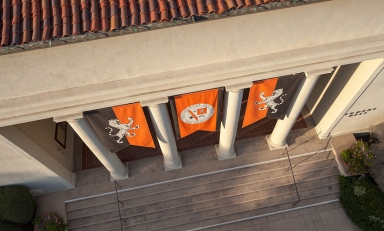Grain by painstakingly applied grain, a group of red-robed Tibetan Buddhist monks are creating intricate sand art at Occidental College to teach students lessons on attachment, acceptance and the impermanence of life.
The 11 monks from the Drepung Loseling monastery in southern India are creating a 4-foot wide multicolored geometric spiritual design, or mandala, from Dec. 7 to 9 in the lobby of Rangeview Hall. They are on tour for two years, bringing their artistic practice, known in Tibet as dul-tson-kyil-khor, to colleges, universities, museums, and other organizations across the country.
The monks, or lamas, train for about eight years to create this ancient art using chak-purs, serrated metal funnels; kima, metal spoons; and finely ground marble dyed in brilliant hues. Hovering scant inches above the mandala as they work, the monks take care not to breathe on the delicate artwork lest they disturb the design. They work silently from 10 a.m. to 6 p.m., the only sound the skritch-skritch of metal spoons scraping the funnels to deposit the powder in minute amounts on the mandala's flat surface. A photo of the Dalai Lama is propped on a nearby table festooned with flowers, while another table displays handmade crafts and books about Buddhism for sale.
Mandalas have various meanings. On one level, they represent a divine world. On another, they are maps to achieve enlightenment. Thousands of mandalas exist, each emphasizing a different subject, such as wisdom, medicine, and longevity. The mandala being made at Occidental focuses on conflict resolution.
"The mandala is a blueprint of the house of the deity," said Gala Rinpoche, one of the monks. "It is a GPS of the spiritual journey."
The monks will finish the mandala on the morning of Dec. 9. The artwork will be on display for only a short while, though. At 1 p.m. that day, the monks will perform a closing ceremony in which they will chant and recite mantras, meditate, and ritualistically sweep up the sand in a clockwise circular motion.
"The dismantling of the mandala is a very important teaching in Buddhism," Rinpoche said. "It reminds us of the impermanence of life. Nothing lasts forever. Everything ends. Everyone dies. We must learn to accept and deal with the situations and consequences of life, both good and bad."
The monks will give half of the sand to audience members and deposit the other half into an urn. Eventually, they will tip the sand into a river, a symbolic gesture that spreads a healing blessing into the ocean and throughout the world, added Rinpoche.
The Drepung Loseling monks' visit is sponsored by the College's Remsen Bird Fund; the Department of Residential Education and Housing Services; the Office of Religious and Spiritual Life; the Office of Civic Engagement; Office of Student Life; and the College's Intercultural Community Center.
Juls White, a residential education assistant director, organized the monks' visit. The mandala sand art project is part of the College's residential education syllabus, she said, and exposes students to a different culture and art.
The sand paintings are not meant as a statement of artistic beauty, Rinpoche emphasized. "We've become slaves to our own thoughts and desires. This [art] is to educate people on how to be more accepting of life, and thus to become happier."
For more information and the tour schedule of the Drepung Loseling monks, go to: mysticalartsoftibet.org and www.drepung.org.



